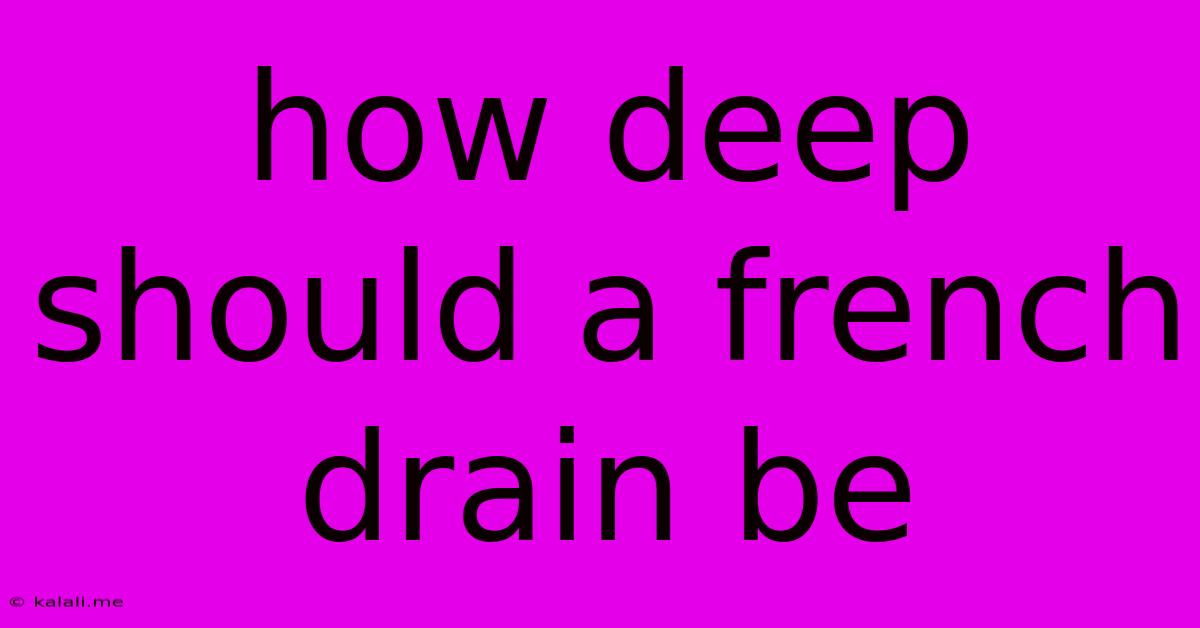How Deep Should A French Drain Be
Kalali
May 22, 2025 · 3 min read

Table of Contents
How Deep Should a French Drain Be? A Comprehensive Guide
French drains are a highly effective solution for managing excess water and preventing costly water damage to your property. But digging the trench to the correct depth is crucial for their success. Getting it wrong can render your entire project ineffective. This guide will cover everything you need to know about determining the optimal depth for your French drain installation.
Key Factors Determining French Drain Depth
The ideal depth for a French drain isn't a one-size-fits-all answer. Several factors influence the necessary depth, including:
-
Your local frost line: This is the depth below the ground's surface where the soil remains frozen during the coldest part of the year. Your drain pipe needs to be below the frost line to prevent freezing and potential damage. You can usually find your area's frost line depth from your local building codes office or a site surveying professional. This is arguably the most crucial factor.
-
The water table: The water table is the level below the ground where the soil is saturated with water. Your drain pipe should be placed below the water table to effectively collect and redirect subsurface water. This often involves some site investigation or prior knowledge of your property’s water table.
-
The type of soil: Different soil types have varying drainage capabilities. Clay soil, for example, retains water much more readily than sandy soil. In clay soils, you might need to dig deeper to ensure proper drainage.
-
The severity of your drainage problem: If you have a significant water drainage issue, a deeper drain might be necessary to handle the increased water volume. Conversely, a less severe issue may require a shallower drain.
-
The slope of the land: The slope of your land will influence the drain's direction and the overall effectiveness of the system. A steeper slope might allow for a shallower drain, while a flatter slope may require a deeper one to ensure proper water flow.
The General Rule of Thumb
While the specific depth varies, a general guideline suggests placing the French drain pipe at least 12 to 18 inches below the surface of the ground. This allows sufficient depth to accommodate the frost line in many areas, while also placing it below the water table in many common situations. However, always prioritize determining your frost line depth and considering your specific soil conditions and water table level.
Understanding the Components and Their Placement
A properly functioning French drain system typically involves:
-
A perforated pipe: This allows water to enter the system. The perforations should be facing downwards.
-
Gravel or crushed stone: This surrounds the perforated pipe and acts as a filter, allowing water to enter the pipe while preventing soil from clogging it.
-
Geotextile fabric: This fabric is wrapped around the gravel and pipe to prevent soil from mixing with the gravel, ensuring the longevity and functionality of the drainage system.
The gravel and pipe should be placed at the calculated depth, with the geotextile fabric extending beyond them to prevent soil infiltration.
When to Seek Professional Help
If you're unsure about any aspect of your French drain installation, especially determining the correct depth, it's best to consult with a professional drainage contractor. They possess the expertise and equipment to accurately assess your property's drainage needs and install a system that’s effective and long-lasting. They can also advise on the most appropriate pipe materials and installation techniques to suit your specific ground conditions.
By carefully considering these factors and following these guidelines, you can ensure that your French drain is installed at the optimal depth, effectively managing excess water and protecting your property from water damage. Remember, a well-planned and correctly installed French drain will significantly increase the value and functionality of your property for years to come.
Latest Posts
Latest Posts
-
Mac Calendar Is Not Syncing With Iphone
May 22, 2025
-
What Does Bitte Mean In German
May 22, 2025
-
How Much Does A Bulb Of Garlic Weigh
May 22, 2025
-
What To Say To Someone Before An Operation
May 22, 2025
-
Best Race In Skyrim For Magic
May 22, 2025
Related Post
Thank you for visiting our website which covers about How Deep Should A French Drain Be . We hope the information provided has been useful to you. Feel free to contact us if you have any questions or need further assistance. See you next time and don't miss to bookmark.